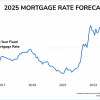
“You better lock your mortgage before the Fed hikes rates.”
“Mortgage rates follow the 10-year Treasury pretty much perfectly.”
“Mortgage rates can’t fall unless the Fed cuts rates.”
As a mortgage rate shopper, you have probably heard these statements from friends and even supposed experts. Unfortunately, they are all dead wrong.
Here’s a primer on how the Fed and US Treasuries affect mortgage rates and how to shop for your mortgage accordingly.
Check today's mortgage rates with a lender.
Federal Funds Rate: A Mortgage Rate Influencer, Not Dictator
Let’s start with the benchmark rate – the Federal Funds Rate (FFR) – the rate set by the Fed.
This rate is currently set at a range between 5.25-5.50%, making the Effective Federal Funds rate 5.33%. This benchmark rate determines the direction of all other rates. Right now it’s at its highest in over 20 years, hence elevated rates for everything else.
Throughout the current monetary tightening cycle, which started in March 2022, rates didn’t rise following every rate hike. This is because of the Fed’s “forward guidance.”
The Fed started this practice in 2000. The idea is that, instead of shocking the markets, the Fed would communicate where they think rates are headed and what to expect from monetary policy before a rate hike or cut.
As a mortgage rate shopper, it’s not worth waiting for the Fed to actually hike or cut. Future actions are already “priced into” today’s mortgage rates.
The chart below shows that mortgage rates started rising in January 2022 even though the first hike was in March 2022. The Fed communicated in advance.
Image: St. Louis Fed. Data: Board of Governors, Freddie Mac. Notation added.
Mortgage rates can also change even though the Fed Fund Rate doesn’t move.
The Fed Rate hasn’t changed from 5.33% since August 2023 but mortgage rates have bounced up and down since then (see above chart again). The Fed reminds markets that they are data-dependent. The swings were due to new data such as inflation, and “Fed speak” – public Fed comments – while the benchmark rate remained unchanged.
Forward guidance is the reason rates improved in December and January. Based on Fed Chair Jerome Powell’s comments, the markets expected six cuts worth 150 basis points (1.5%) in 2024.
When it was clear that wouldn’t materialize, rates worsened. Expectations are now for just a 0.50% reduction this year. This is an example of future policy already “priced in” or “baked in” to current rates. So, a hike or a cut doesn’t mean mortgage rates will move accordingly. Instead, these moves impact the direction of rates over time.
Is the 10-Year Treasury a Better Predictor of Mortgage Rates?
Mortgage rates correlate to the 10-year Treasury, but not perfectly.
(Why the 10-year Treasury and not the 30-year? A typical mortgage pays off in about seven years.)
Some days, the yield on a 10-year Treasury goes down while mortgage rates remain unchanged or rise.
This is because, on any given day, the yield (the interest rate paid by the bond) depends on liquidity within that specific market.
Check today's rates with a lender.
For example, if the yield on a 10-year drops today, it’s because more investors are buying US Treasuries, specifically long-term Treasuries. They happen to feel good about this financial asset. They may not feel the same way about mortgage bonds, also known as mortgage-backed securities (MBS).
Supply and demand in bond markets play out just like in other markets. During COVID, everyone wanted a Peloton. But then, oversupply met dropping demand. Peloton prices fell.
When no one is buying mortgage bonds, prices fall and yields (interest rates) rise.
Demand for mortgage bonds ultimately determines yields and rates. These supply/demand dynamics are changing every day.
Many articles mention the 10-year Treasury/30-year mortgage rate spread to show how high mortgage rates are today. By one estimate, the currently high spreads are costing homebuyers $168 per month.
Historically, the spread between the two has been around 150 basis points, whereas recently, it has reached 300 basis points (3.0%), so double a “normal” level.
Today's 10-year Treasury rate is 4.46%. At normal spreads, the 30-year fixed rate would be around 5.96% -- yes, under 6%. But the average rate according to the Mortgage Research Network rate tracker is 7.06% -- more than 1% higher that it "should" be. (Rates are averages and may not be available).
When there’s uncertainty about the direction of interest rates, this spread widens, causing mortgage rates to be higher than they should based on the 10-year Treasury rate.
Investing in a mortgage is riskier than investing in a US Treasury. This plays out in the current environment versus in 2018 when things were considered more “normal,” as shown in this chart
Image: St. Louis Fed. Data: Board of Governors, Freddie Mac. Notation added.
Overall, it’s another myth that the 10-year exactly determines mortgage rates. The spread has a mind of its own.
Capturing a Good Mortgage Rate
Even experts who have tracked mortgage rates for decades are surprised by rate movements. Like the economy as a whole, interest rates can be wildly unpredictable.
That’s why it’s unwise to either feel rushed or wait too long to capture rates on the best possible day. It’s nearly impossible. Rather, get pre-approved for a payment you can afford, then lock in your rate when you find a house.
If you're refinancing, lock in your rate when you can save money monthly or accomplish another goal, like converting home equity to cash.
Get a rate quote and start on your home purchase or refinance here.






